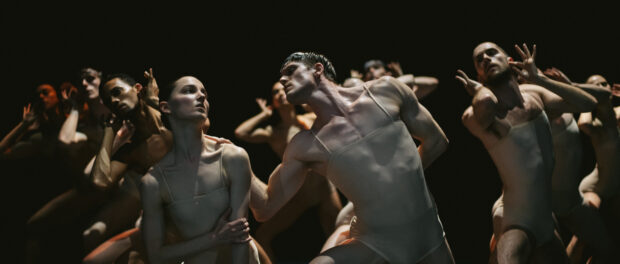Nederlands Dans Theater: Two misses and a hit
Technically stunning, artistically a little disappointing.
One of Europe’s most renowned contemporary dance companies, The Nederlands Dans Theater performed three works by three different choreographers (or sets of choreographers) at Théâtre Maisonneuve this week. While all three works featured impeccable technique, hard-hitting electronic soundtracks, and masterful lighting that was integral to each performance, only one of the three seemed to access something below the surface artistically.
The first work, The Point Being by sibling choreographers Imre and Marne van Opstal, begins with the stage in semi-darkness, behind a sort of sheer curtain. Most of the dancers lie on their sides on the floor, as if sleeping. One, however, appears to be running in slow motion towards a standing figure at the back of the stage. The ingenious lighting, in conjunction with the electronic soundtrack, gave an almost post-apocalyptic sci-fi feel, immediately drawing the audience in. Eventually the sleeping figures awake, and a series of ensemble, duo, trio, and solo dances ensues. The movements are fascinating and beautiful and unique, but the intrigue of the opening scene fairly quickly dissipates, and I was left asking exactly the question that is the title of the work: the point being?
The second piece, One Flat Thing, reproduced, by William Forsythe, seemed at first to hold out more promise. The curtain rises and the entire group of dancers rushes towards the front of the stage pulling fifteen or so rectangular tables behind them. This onslaught, combined with the loud electronic soundtrack, the colourful clothing, and the non-stop athleticism on top of, below, and around the tables dazzles. But, like the first piece, it ultimately feels superficial, like watching fast, colourful cars race around a track or billiard balls caroming off the edges of pool tables. Which is, perhaps the point, but I found it ultimately too superficial. In all that frenetic energy I was reminded a bit of certain pieces by Marie Chouinard, but with Chouinard I usually (not always) sense a layer of meaning or a greater import or some connection to something bigger than the spectacle itself. In this piece, despite being moderately entertained, and impressed by the dancers’ abilities (and enchanted by their colourful socks), I ended up feeling like I had eaten a big handful of jelly beans: fun colours, cool flavours, but somehow not very satisfying.
The third piece, Jakie, by Sharon Eyal and Gai Behar, redeemed the evening. In all honesty I can’t explain exactly why or how; I can’t point to something concrete that was present in this work that was missing in the others. It was just that awareness in the pit of your stomach and in the goosebumps on your flesh that something more than technical display was unfolding on stage.
The work starts with all the dancers huddled in shadows at the back of the stage, en pointe, seeming to shimmer and vibrate together. Dressed in flesh-coloured body suits, they appear naked. The lighting highlights their buttocks, which flex subtly as the dancers take tiny steps from side to side in a sort of sci-fi homage to ballet. There are echoes in this piece of Eyal and Behar’s Soul Chain, performed recently by tanzmainz (link to article). Over the course of the piece the dancers move primarily en masse, sometimes expanding to fill the stage but often keeping close together. Similarly to Soul Chain, often one dancer does something a little different from the group: a tall figure looms up at the back as the group crouches down a little lower, or a woman on the side makes her leg vibrate as if it’s electronically possessed.
Over the course of the work the dancers alternate between ballet-like movements and something resembling club dancing. Like in Soul Chain, I had the feeling that aliens had landed from another planet and were exploring the world of human dance, as if the replicants in Bladerunner were spending an evening at the ballet and then going out to join the throngs of dancers in nightclubs. Or as if the restricted, controlled movements of ballet eventually give way to the full range of what a body can do if it’s not so inhibited. There’s a smoldering, below-the-surface sexuality that sometimes fully emerges in the form of more obvious pelvic gyrations and other movements. It is often somewhat kept in check, simmering just below the surface. When it does break through to embodiment, it’s almost as if the replicants/dancers don’t know what to make of it.
Nederlands Dans Theater was at Théâtre Maisonneuve March 20-23.






